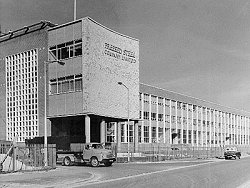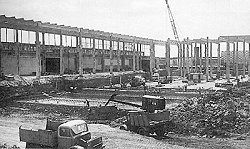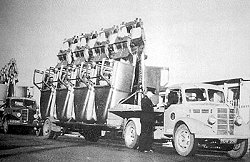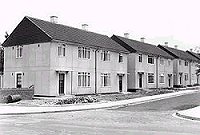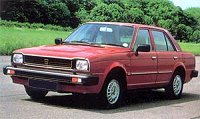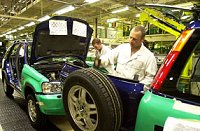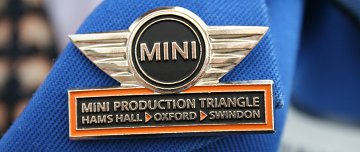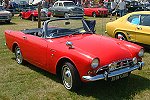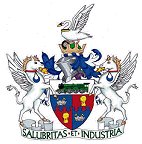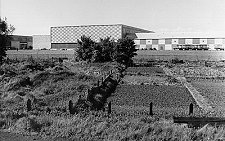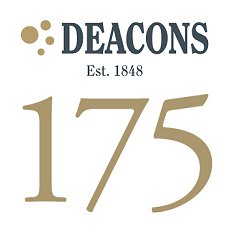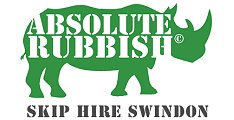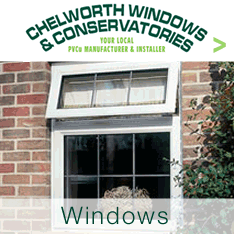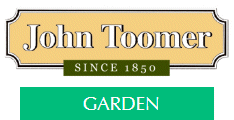The Car Industry in Swindon
The rise of UK's new Motown
History tells us that Swindon is a railway town, but for the last half a century, the undisputed king has been the car. Countless volumes have been written to celebrate Swindon's railway heritage - and rightly so - but the place of the car in the town's history has been relegated to little more than a footnote in comparison.
A contribution largely ignored
Perhaps the clearest example of the way local historians have neglected the industry over the years can be found in the authoritative A History of Swindon to 1965, which was published by the Wiltshire Library and Museum Service. After reading through the detailed history of the development of Swindon and its railway factory, the reader is eventually told, on page 131: 'In 1954 the Pressed Steel Co. established a factory just over the borough boundary, in Stratton St Margaret, which in 1965 employed 6,595 people.'
That an industry employing over 6,000 people on a single site should be relegated to so small a mention in the town's history is surprising enough, but the next sentence puts the role of the new car body manufacturing plant in its full context.
That date was 25th June, 1952, when Swindon received Government approval for its development plan to be an overspill centre for London as the capital continued its long recovery from the Second World War. It marked the beginning of an era that would see Swindon attract a great many other industries - and the charge to Swindon was led by The Pressed Steel Company. Better known locally as simply 'Pressed Steel' (even during later years when it was officially called Pressed Steel Fisher and even through various other name changes) the company made possible the prosperity that Swindon would enjoy over the following few decades.
Leading Swindon's post-war prosperity
It would be difficult to overstate the importance of Swindon's strategic plan in 1952 or exaggerate just how crucial Pressed Steel's arrival was as a catalyst for the relentless expansion of Swindon which still continues today. As Swindon: A Town in Transition, a history written in 1975, points out, Pressed Steel - along with two other major employers, Vickers and Plessey - formed the hard core of the new expansion and diversification of Swindon's industry. In their wake, many smaller firms followed - it needed a decision by one or two large firms to locate in Swindon before the smaller ones would take the risk. However, after Pressed Steel came and Vickers and Plessey began to expand, the next few years were ones of rapid expansion.
Yet Pressed Steel never really planned to come to Swindon and probably would not have come if circumstances had been different. The company really wanted to build an extension to its Cowley operation in Oxford, but pressure from central government persuaded bosses to look, instead, to one of the designated development areas. The company looked at several sites in the south, even as far as Portsmouth, recalled the Pressed Steel's own review of the Swindon move in 1960. Finally Swindon was chosen, largely because of its strategic position in relation to Cowley and the motor industry centres of Birmingham and Coventry, as well as the advantages offered by its impending industrial developments.
The new factory was built on the site of Parsonage Farm in Stratton St. Margaret - ironically, on land not actually owned by Swindon Corporation, which had worked so hard to attract the new employer. It was actually part of the old Highworth Rural District Council, so rates were paid to that.
Although the land was bought in 1954, it was New Year's Eve 1955 before the first car body panel was stamped in Swindon, and the factory expanded rapidly over the next five years. The original phase was complete by 1957, but the site almost doubled in size again in 1958.
A random survey of a small number of the workforce in the summer of 1965 showed that around three quarters had been born in London. The survey also showed that of the entire workforce of nearly 6,600, only 92 were women - and just 220 were under 21. In contrast, 94 per cent were married men - which underlines why the factory itself was only half the story. Not only did all these newcomers need homes - but most of them brought families with them who also needed to be housed.
As a direct result, other services industries also grew up and expanded in the shadow of the works - some, quite literally. This included the likes of British Road Services (BRS), which had a large depot at Greenbridge, close to the new factory. Swindon had become the proverbial boom town and Pressed Steel's workers were also part of a thriving British car industry that was part of a slow-growing prosperity in the 1950s and 1960s. Britain had never had it so good - and though we now know that it wasn't going to last, Swindon, as usual, proved a great survivor when the decline came. Just when it seemed that all the wheels were falling off the car industry in the troubled 1970s and 1980s, the Swindon factory must have seemed like a beacon. It simply refused to die, regardless of the ever-changing scene around it. By 1952, a string of manufacturers (Morris, MG, Wolseley, Riley, Austin, Austin-Healey and Vanden Plas) had been rationalised into the British Motor Corporation (BMC) and the addition of Jaguar, Daimler and Pressed Steel in 1966 produced British Motor Holdings (BMH).
If it looked like the combination of all those great marques into one corporation was the highlight of the industry, we now know that the opposite was true. British Leyland is a name that will be forever associated with a decline so terminal that successive governments of different colours were forced into desperate measures to stop the rot. Nationalisation of BL in 1975 was followed by the hiving off of its more sellable parts in the 1980s - and staff at the Swindon factory could have been excused for wondering not only where their futures were, but whether the factory had a future at all.
The arrival of Honda
However, from the ashes of BL came the Rover Group, and it was Rover's flag that was hoisted on to the front gates of the site - although, in 1990, a partnership between Rover and Honda meant that the factory was 20 per cent owned by the Japanese company.
Even if the factory's identity crisis seemed to be getting worse, that collaboration proved to be another milestone in Swindon's history because its success led directly to Honda giving the town a massive vote of confidence in 1985. Swindon would eventually become not just home to a major Honda factory, but the centrepiece of the firm's whole European car operation which now also includes the manufacture of cars for the American market. Utilising part of the old Vickers site at South Marston, which had helped with wartime Spitfire production, the site would eventually grow to 1.5million square metres - three times larger than even the Pressed Steel site.
The official HUM website makes it clear why Swindon was its first choice as a European centre, explaining that it has 'excellent people... excellent infrastructure... and good communications and work facilities'. Finally, it points out, 'one very important factor for Honda was the warm welcome received from the local community.' While Honda blossomed in Swindon and Swindon blossomed thanks to Honda, workers at the old Pressed Steel plant might have been excused for being less optimism about their own futures again as Rover was bought by BMW and then quickly sold again. But what followed is another tribute to the abillity of Swindon in general and the Pressed Steel/BL/Rover workers in particular to reinvent themselves and prosper.
New era under BMW
While BMW's bosses were busy disposing of its former Rover assets, they were impressed enough by what they saw at Swindon to make the decision to retain ownership of the car body plant - and in 2000 it began trading as Swindon Pressings Ltd (SPL). A return to an apparently independent identity (now called BMW Plant Swindon) that could be said has brought the business full circle, back to the Pressed Steel era. It's certainly true that Pressed Steel Fisher/Swindon Pressings/BMW Plant Swindon is nothing if not a remarkable survival story.
Although, remember, the workforce was 6,600-strong in 1965, in an age when the industry has been revolutionised by robotics and other cutting edge technology, it is impressive that around 2,000 people still work at the Swindon factory, which also has a satellite plant in Birmingham. The site itself is still as massive as it has ever been, covering 425,000 square metres. That's enough to accommodate 85 football pitches - and makes it the largest independent presssings location in the whole of Europe. Although the plant cannot and never has manufactured whole cars, it provides a complete facility for body part production from feasibility through prototyping, design, tooling, project management, pressing and assembly. Today the factory is completed dedicated to producing panels for BMW's phenomenally successful new Mini (which we have three!), which are assembled at Oxford.
The plant a key corner stone in what BMW desribe as the 'Mini Triangle' - Swindon, Oxford and Hams Hall, near Coventry, where the Mini engines are manufactured.
BMW Plant Swindon's turnover is now over £250million per annum and to cope with the constant demand for its products, the parent company have embarked on a major investment programme. With the plant also selected to produce parts for the new Mini Clubman, and convertible, nobody can argue with current managing director Klaus Hauser's ringing endorsement for what the Swindon workforce have achieved - and can achieve
'Swindon has emerged from its past to become a high-tech business that earns its place in the BMW production network of the future,' he told us. With BMW and Honda and now half a century of experience behind it, not only has Swindon a key role to place in the car industry today - but it also seems set to be a major player for years to come.
Not bad for a railway town. Factfile and links:
The Sunbeam Alpine, a sports car from the late 1950s which gained something of a cult following until it ceased production in 1968, was largely designed by Ken Howes, who was born in Swindon. Howes served his apprenticeship in Swindon Railway Works and later worked at Ford's car body styling centre in Detroit before returning to England. It's not difficult to see the American influence in Howes' exotic design for the Alpine.
Swindon's motor industry finally got official recognition when Swindon Borough Council updated the town's coat of arms in 1997. If you look closely at the swan, which has sat on top of the coat of arms since 1974 and represents the nearby Thames and the Warneford family of Highworth, you can see that it now has one of its feet on a car wheel. Incidentally, the railway industry was not represented on the coat of arms between 1974 and 1997.
Rather like Swindon's railway works, the Pressed Steel site was conceived as a self-contained industrial complex in itself, featuring a canteen, laboratory, fire station, electricity sub-station and its own railway and sidings. The little railway network, which partly traces the route of the old Highworth Branch line, connects directly with the main line.
Cars partly or wholly built in Swindon include: Triumph 2000, Triumph Spitfire, Austin Healy Sprite, Austin 1100, MG Midget, MGB, MG ZA Magnatte, Land Rover, Range Rover, the new BMW Mini, Rover 75 Tourer, Honda Civic, Honda Accord, Honda CR-V.
Pressed Steel Fisher had a railway division, producing wagons and coaches - but not in Swindon.
Parsonage Farm was bought by Pressed Steel in 1954 and the first sod was cut in February 1955. The farm was known to be boggy and this caused problems with early building work, as this account from the company's own publication recalls: 'As installation went on through the winter... the new buildings became a sea of mud, through which presses and other heavy machinery had to be dragged by coupled bulldozers. One press which got temporarily out of control began to sink into the ground and the men had to dig twenty feet down beneath it before finding adequate foundation for jacking it up.'
In 1960 Pressed Steel said they saw 'no reason why industrial architecture should not, in its own idiom, be as attactive as any other' and were obviously proud of the design of their new Swindon factory, which has stood the test of time and which stood as a good example of industrial architecture of the period until it was demolished in 2006. A survey in 1965 showed that less than half of Swindon's Press Steel workers owned a car. |
|
||||||||
|
Vickers in Skirts |
||||||||
|
||||||||
|
||||||||
|
||||||||
|
||||||||
|
||||||||
|
||||||||
|
||||||||
|
||||||||
|
||||||||
|
|||||||||






